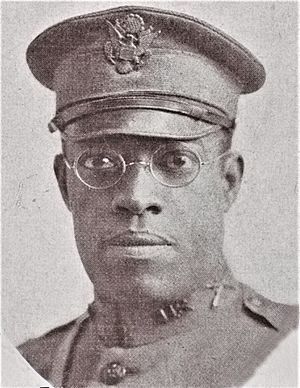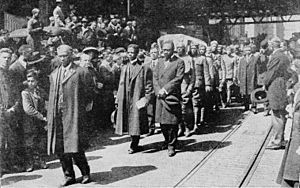James Reese Europe facts for kids
Quick facts for kids
James Reese Europe
|
|
|---|---|

Lt. James Europe
|
|
| Background information | |
| Also known as | Lieut. Jim Europe |
| Born | February 22, 1881 Mobile, Alabama, US |
| Died | May 9, 1919 (aged 38) Boston, Massachusetts, US |
| Genres | |
| Occupation(s) |
|
| Instruments | Violin, piano |
| Associated acts |
|
James Reese Europe (February 22, 1881 – May 9, 1919) was an American ragtime and early jazz bandleader, arranger, and composer. He was a very important person in the African Americans music scene in New York City during the 1910s. Famous musician Eubie Blake even called him the "Martin Luther King of music."
Contents
Early Life
James Reese Europe was born in Mobile, Alabama. His parents were Henry Jefferson Europe and Loraine Saxon. When he was 10 years old, his family moved to Washington, D.C. Later, in 1904, Europe moved to New York City. He had a son named James Reese Europe Jr.
A Leading Band Leader
In 1910, Europe started the Clef Club. This was a special group for Black American musicians. In 1912, the Clef Club made history. They played a concert at Carnegie Hall to help the Colored Music Settlement School.
The Clef Club Orchestra was not a jazz band yet. But they were the first group to play early jazz music at Carnegie Hall. This was a huge moment for jazz music in the United States. It happened many years before other famous jazz concerts there. The Clef Club played music only by Black composers.
Europe's orchestra was very large. It was not a small band like some others at the time. It had 125 members! They played at Carnegie Hall several times between 1912 and 1915. People loved their music, which often included plantation melodies and spirituals.
James Europe was known for being strong-willed. He always wanted to play his own style of music. He once said, "We have developed a kind of symphony music that... is different and distinctive." He believed in sticking to the music of his own people. He felt that Black people had their own special music. He said it was "the product of our souls."
He was one of the first African-American musicians to become widely known.
His Music
Some of Europe's most famous songs were written with Ford Dabney. They wrote these songs for the popular dancers Irene and Vernon Castle. The Castles really liked Europe's band. They hired him as their main band leader in 1913.
Here are some songs he helped create:
- The Castle Walk trot
- Argentine tango
- Castle Combination
- Congratulations Valse
- Castle Valse Classique – this was a new version of a song by Antonín Dvořák.
- Castle Perfect Trot
- Castle Maxixe (a Brazilian dance)
- Castles Half and Half – this song had a unique rhythm.
- Enticement – a tango song.
- At That San Francisco Fair – a song for a musical.
He also wrote songs for musicals like Nobody Home and Midnight Frolic.
James Europe also wrote some songs all by himself for the Castles, like Castle Doggy foxtrot.
Military Service

During World War I, James Europe joined the New York Army National Guard. He became a lieutenant and fought with the 369th Infantry Regiment. This regiment was also known as the "Harlem Hellfighters." They were sent to fight with the French Army.
Europe also led the regiment's band, which became very famous. In 1918, James Reese Europe and his military band traveled over 2,000 miles in France. They played for British, French, and American soldiers, and also for French people. The "Hellfighters" band also made their first recordings in France. Their concerts included French marches and American songs like "The Memphis Blues." A band member named Noble Sissle said their music "started ragtimitis in France."
After the War
When he came back home in 1919, Europe said something important. He believed that Black musicians should create their own music. He said, "We won France by playing music which was ours." He felt that if Black musicians copied others, they would not be as good. He wanted them to develop their own unique style.
In 1919, Europe made more recordings. These songs included blues and early jazz sounds. He also recorded with a singer named Noble Sissle. Noble Sissle later became very successful with his musical Shuffle Along.
His Death
On May 9, 1919, James Europe played his last concert. He had been feeling unwell. During a break, he had a disagreement with one of his drummers. Sadly, the drummer injured him in the neck. The injury seemed small at first. Europe even told his band to finish the concert. But at the hospital, doctors could not stop the bleeding, and he passed away a few hours later.
News of Europe's death spread quickly. Many people were very sad. Musician W. C. Handy wrote about how shocking it was. James Europe was given the first public funeral for a Black American in New York City. People said that he had helped many Black musicians become important. He was seen as a leader and a true friend to his community.
At the time of his death, James Reese Europe was the most famous Black-American bandleader in the United States. He was buried at Arlington National Cemetery in Arlington, Virginia.
The drummer, Herbert Wright, was found guilty of manslaughter and spent eight years in prison.
See also
 In Spanish: Jimmy Reese Europe para niños
In Spanish: Jimmy Reese Europe para niños
- The Frogs (club)
- African American musical theater



